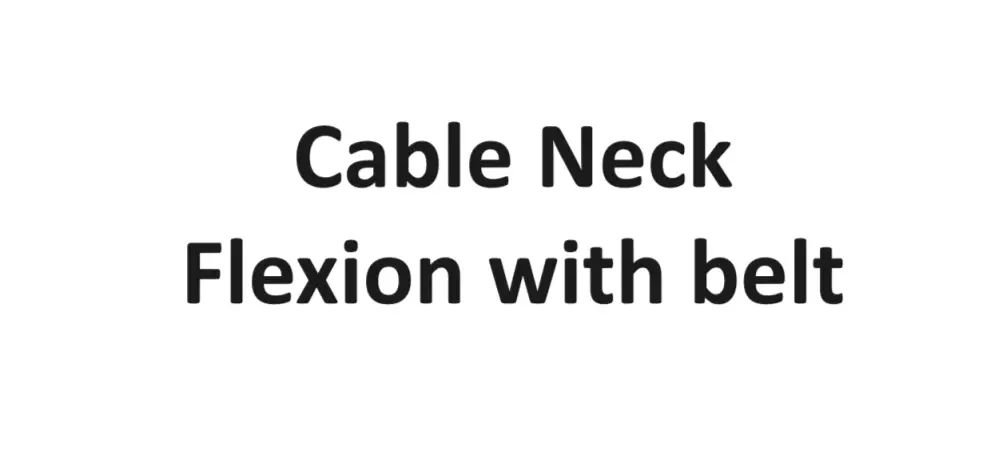Cable Neck Flexion with belt is a variation of the standard Cable Neck Flexion exercise. This variation involves using a belt or strap to provide additional resistance and support during the exercise. By attaching the belt to the cable machine and securing it around the forehead or back of the head, you can increase the intensity of the exercise and target the muscles of the anterior neck more effectively. In this comprehensive guide, we’ll explore the correct technique, benefits, variations, and other essential details associated with Cable Neck Flexion with belt.
Instructions
Setup:
- Adjust the Cable Machine: Attach a belt or strap to the lowest setting on a cable machine. Ensure that the weight stack is set at an appropriate resistance level.
- Position Yourself: Stand facing away from the cable machine with your feet shoulder-width apart and knees slightly bent. Adjust the distance from the machine to ensure there is tension on the belt when your head is in a neutral position.
Execution:
- Starting Position: Stand tall with your spine in a neutral position and your shoulders relaxed. Keep your arms by your sides or hold onto a stable surface for support.
- Neck Flexion: Inhale and slowly flex your neck forward, bringing your chin towards your chest. Keep your movements slow and controlled, focusing on engaging the muscles of the anterior neck.
- Peak Contraction: Once you reach a comfortable point of flexion, pause briefly to squeeze the muscles at the front of your neck. Focus on maintaining tension in the muscles throughout the contraction.
- Return to Starting Position: Exhale as you slowly extend your neck back to the starting position, resisting the pull of the cable. Maintain control over the movement to prevent jerking or sudden movements.
- Repeat: Perform the desired number of repetitions with proper form and control, aiming for a full range of motion and avoiding any excessive strain on the neck muscles.
Benefits
- Increased Resistance: Using a belt or strap adds resistance to the Cable Neck Flexion exercise, making it more challenging and effective for strengthening the muscles of the anterior neck.
- Improved Muscle Engagement: The added resistance helps to increase muscle activation in the anterior neck muscles, leading to greater strength gains and muscle development.
- Enhanced Stability: The belt provides support and stability during the exercise, allowing for better control of the movement and reducing the risk of injury.
- Variety: Cable Neck Flexion with a belt offers a variation to standard neck flexion exercises, helping to prevent plateaus and keep workouts interesting.
Muscles worked in Cable Neck Flexion with belt
Cable Neck Flexion with belt primarily targets the muscles of the anterior neck, specifically the sternocleidomastoid and anterior scalene muscles. These muscles play a significant role in flexing the neck forward and tilting the head downward. Additionally, other muscles of the neck, including the platysma and longus colli muscles, may also be engaged to a lesser extent during this exercise.
Here’s an overview of the main muscles worked during Cable Neck Flexion with belt:
- Sternocleidomastoid (SCM): The sternocleidomastoid is a large muscle located on each side of the neck. It originates from the sternum and clavicle and inserts into the mastoid process of the temporal bone. Contraction of the SCM muscle causes neck flexion and rotation to the opposite side.
- Anterior Scalene: The anterior scalene is a small muscle located on the side of the neck. It originates from the transverse processes of the cervical vertebrae and inserts into the first rib. Contraction of the anterior scalene assists in neck flexion and lateral flexion of the neck.
- Platysma: The platysma is a thin, broad muscle that covers the front of the neck. It originates from the fascia of the chest and shoulders and inserts into the lower jaw and corners of the mouth. Contraction of the platysma helps depress the jaw and lower lip, as well as tense the skin of the neck.
- Longus Colli: The longus colli is a deep muscle located on the front of the neck. It consists of three parts: superior, inferior, and vertical. Contraction of the longus colli muscles helps flex the neck forward and stabilize the cervical spine during movement.
Overall, Cable Neck Flexion with a belt effectively targets these muscles, helping to strengthen and tone the anterior neck muscles, improve neck stability, and enhance overall neck health and function. It is important to perform this exercise with proper form and control to minimize the risk of injury and maximize the benefits.
Alternate names for Cable Neck Flexion with belt:
- Neck Flexion with Cable Belt
- Cable Neck Extension with Belt
- Belted Cable Neck Flexion
- Neck Curl with Cable Belt
Variations
- Single-Arm Cable Neck Flexion: Perform the exercise with one arm at a time to isolate and strengthen each side of the neck individually.
- Seated Cable Neck Flexion: Sit on a bench or chair facing the cable machine to perform the exercise in a seated position, which may provide additional stability and support.
- Cable Neck Extension: Instead of flexing the neck forward, extend the neck backward against the resistance of the cable to target the muscles at the back of the neck.
Conclusion
Incorporating Cable Neck Flexion with belt into your workout routine can be an effective way to target and strengthen the muscles of the anterior neck. By following the proper technique and gradually increasing the resistance, you can experience the benefits of improved neck strength, stability, and muscle development. Remember to listen to your body, use appropriate weights, and consult with a fitness professional if you have any concerns or questions about incorporating this exercise into your routine.








